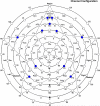Low-Frequency Repetitive Transcranial Magnetic Stimulation (rTMS) Modulates Evoked-Gamma Frequency Oscillations in Autism Spectrum Disorder (ASD)
- PMID: 21116441
- PMCID: PMC2992386
- DOI: 10.1080/10874208.2010.501500
Low-Frequency Repetitive Transcranial Magnetic Stimulation (rTMS) Modulates Evoked-Gamma Frequency Oscillations in Autism Spectrum Disorder (ASD)
Abstract
INTRODUCTION: It has been reported that individuals with Autism Spectrum Disorder (ASD) have abnormal reactions to the sensory environment and visuo-perceptual abnormalities. Electrophysiological research has provided evidence that gamma band activity (30-80 Hz) is a physiological indicator of the co-activation of cortical cells engaged in processing visual stimuli and integrating different features of a stimulus. A number of studies have found augmented and indiscriminative gamma band power at early stages of visual processing in ASD; this may be related to decreased inhibitory processing and an increase in the ratio of cortical excitation to inhibition. Low frequency or 'slow' (≤1HZ) repetitive transcranial magnetic stimulation (rTMS) has been shown to increase inhibition of stimulated cortex by the activation of inhibitory circuits. METHODS: We wanted to test the hypothesis of gamma band abnormalities at early stages of visual processing in ASD by investigating relative evoked (i.e. ~ 100 ms) gamma power in 25 subjects with ASD and 20 age-matched controls using Kanizsa illusory figures. Additionally, we wanted to assess the effects of 12 sessions of bilateral 'slow' rTMS to the dorsolateral prefrontal cortex (DLPFC) on evoked gamma activity using a randomized controlled design. RESULTS: In individuals with ASD evoked gamma activity was not discriminative of stimulus type, whereas in controls early gamma power differences between target and non-target stimuli were highly significant. Following rTMS individuals with ASD showed significant improvement in discriminatory gamma activity between relevant and irrelevant visual stimuli. We also found significant improvement in the responses on behavioral questionnaires (i.e., irritability, repetitive behavior) as a result of rTMS. CONCLUSION: We proposed that 'slow' rTMS may have increased cortical inhibitory tone which improved discriminatory gamma activity at early stages of visual processing. rTMS has the potential to become an important therapeutic tool in ASD treatment and has shown significant benefits in treating core symptoms of ASD with few, if any side effects.
Figures






Similar articles
-
Repetitive Transcranial Magnetic Stimulation (rTMS) Modulates Event-Related Potential (ERP) Indices of Attention in Autism.Transl Neurosci. 2012 Jun 1;3(2):170-180. doi: 10.2478/s13380-012-0022-0. Transl Neurosci. 2012. PMID: 24683490 Free PMC article.
-
Low-frequency repetitive transcranial magnetic stimulation (rTMS) affects event-related potential measures of novelty processing in autism.Appl Psychophysiol Biofeedback. 2010 Jun;35(2):147-61. doi: 10.1007/s10484-009-9121-2. Appl Psychophysiol Biofeedback. 2010. PMID: 19941058 Free PMC article. Clinical Trial.
-
rTMS neuromodulation improves electrocortical functional measures of information processing and behavioral responses in autism.Front Syst Neurosci. 2014 Aug 6;8:134. doi: 10.3389/fnsys.2014.00134. eCollection 2014. Front Syst Neurosci. 2014. PMID: 25147508 Free PMC article.
-
Autism spectrum disorders: linking neuropathological findings to treatment with transcranial magnetic stimulation.Acta Paediatr. 2015 Apr;104(4):346-55. doi: 10.1111/apa.12943. Acta Paediatr. 2015. PMID: 25626149 Review.
-
[Repetitive transcranial magnetic stimulation in major depression: response factor].Encephale. 2012 Sep;38(4):360-8. doi: 10.1016/j.encep.2011.08.004. Epub 2011 Oct 11. Encephale. 2012. PMID: 22980479 Review. French.
Cited by
-
A Temporal Sampling Basis for Visual Processing in Developmental Dyslexia.Front Hum Neurosci. 2020 Jul 8;14:213. doi: 10.3389/fnhum.2020.00213. eCollection 2020. Front Hum Neurosci. 2020. PMID: 32733217 Free PMC article.
-
Exploratory Study of rTMS Neuromodulation Effects on Electrocortical Functional Measures of Performance in an Oddball Test and Behavioral Symptoms in Autism.Front Syst Neurosci. 2018 May 28;12:20. doi: 10.3389/fnsys.2018.00020. eCollection 2018. Front Syst Neurosci. 2018. PMID: 29892214 Free PMC article.
-
Transcranial magnetic stimulation in autism spectrum disorder: Challenges, promise, and roadmap for future research.Autism Res. 2016 Feb;9(2):184-203. doi: 10.1002/aur.1567. Epub 2015 Nov 4. Autism Res. 2016. PMID: 26536383 Free PMC article. Review.
-
Ringing Decay of Gamma Oscillations and Transcranial Magnetic Stimulation Therapy in Autism Spectrum Disorder.Appl Psychophysiol Biofeedback. 2021 Jun;46(2):161-173. doi: 10.1007/s10484-021-09509-z. Appl Psychophysiol Biofeedback. 2021. PMID: 33877491
-
The Effect of sequential bilateral low-frequency rTMS over dorsolateral prefrontal cortex on serum level of BDNF and GABA in patients with primary insomnia.Brain Behav. 2019 Feb;9(2):e01206. doi: 10.1002/brb3.1206. Epub 2019 Jan 4. Brain Behav. 2019. PMID: 30609300 Free PMC article.
References
-
- Aman MG. Management of hyperactivity and other acting out problems in patients with autism spectrum disorder. Seminars in Pediatric Neurology. 2004;11:225–228. - PubMed
-
- Aman MG, Singh NN. Aberrant behavior checklist—Community. Slosson Educational Publications; East Aurora, NY: 1994. Supplementary manual.
-
- American Psychiatric Association . Diagnostic and statistical manual of mental disorders (DSM-IV TR) 4th ed. American Psychiatric Association; Washington, DC: 2000. (text revised)
-
- Belmonte MK, Yurgelun-Todd DA. Functional anatomy of impaired selective attention and compensatory processing in autism. Cognitive Brain Research. 2003;17:651–664. - PubMed
-
- Bertrand O, Tallon-Baudry C. Oscillatory gamma activity in humans: A possible role for object representation. International Journal of Psychophysiology. 2000;38:211–223. - PubMed
Grants and funding
LinkOut - more resources
Full Text Sources
Medical
